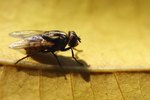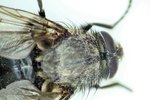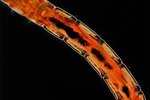
The housefly, or Musca domestica, can be found across the globe both inside and out. Commonly found in places that are in close proximity to humans and animals, the housefly is attracted to a number of different surfaces. They prefer locations with high rates of decay, both to lay their eggs and to feed.
Physiology
There are four stages in the life cycle of Musca domestica. They begin as eggs laid in decaying matter, which hatch to the long, whitish yellow maggot (larvae) stage within 8 to 20 hours. The larvae stage takes between four and thirteen days, but only within optimal temperature range. The third stage is the pupa. During this time, the insect completes the development stage inside its new casing -- this time a dark brown color. In between two and six days, the fly will break free into the adult stage and begin the process again.
Animal Attraction
Houseflies are numerous in areas with a large animal population due to the presence of animal fecal matter. Flies land to feed, so on land that has many animals, the flies will be more abundant. Feeding on decaying matter, flies tend to congregate near horses, cows and pigs. They use the manure piles as well as any open orifice on an animal as a way to gather food, but they do not bite. Animal manure is not the only food source for flies, but because it's so abundant in these locations, it can sustain a large fly population .
Human Garbage
Many flies can be found in homes and buildings where humans are present, too. Unlike the outdoor locations, indoor fly sustenance is gained through decomposing trash and other food waste. Moist, damp foods provide the fly with the nutrition it needs, which is why decaying organic material is the ideal meal. In homes, the temperature tends to speed up the decomposition process, providing the right environment for a fly's food to spoil properly, as well as for the insect to thrive.
Activity Level
Flies are active during the daytime hours, spending their nights away from humans and animals. In outdoor locations, flies rest in branches, bushes and shrubs overnight. In homes and barns, they can be found near or in ceilings. Wires and beams are typical resting locations for the housefly during the nighttime hours.
During the day, flies are most active during the hottest hours, as the rate of decomposition of their food sources speeds up, making the scents more appealing and pungent, and creating an environment ideal for a large fly population.
Breeding Site Attraction
Flies are not only attracted to these locations as food sources. They use dark, moist areas for breeding purposes, too. Manure heaps, trash piles, dumpsters and even decaying animals provide ample breeding locations to the housefly, and food to the larvae that hatch soon after.
The life cycle of the fly only spans about three weeks in optimal conditions, so this process is ongoing throughout the warmest months of the year. Even during cold months, flies can lie in wait in their larval or pupa stages until it's warm enough to continue the growing process.
References
Photo Credits
-
Stockbyte/Stockbyte/Getty Images



